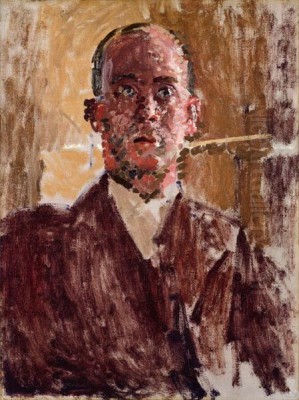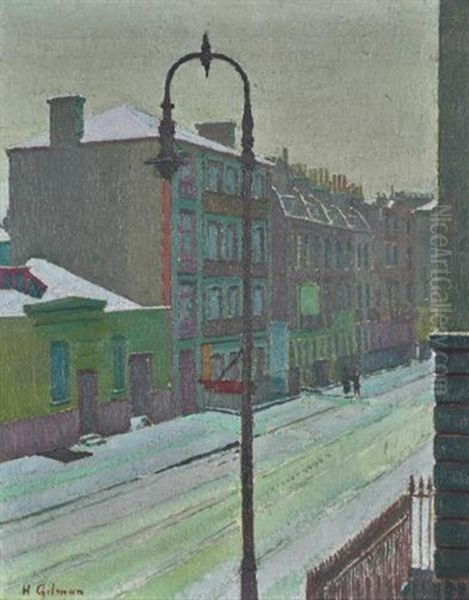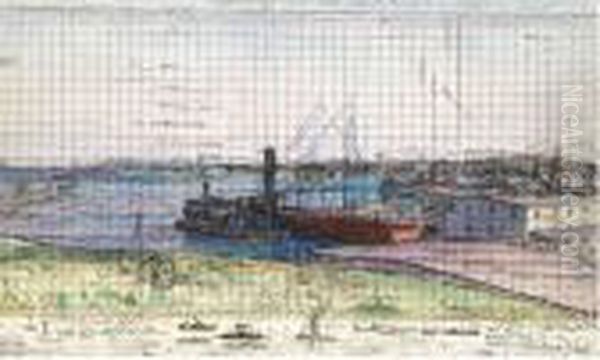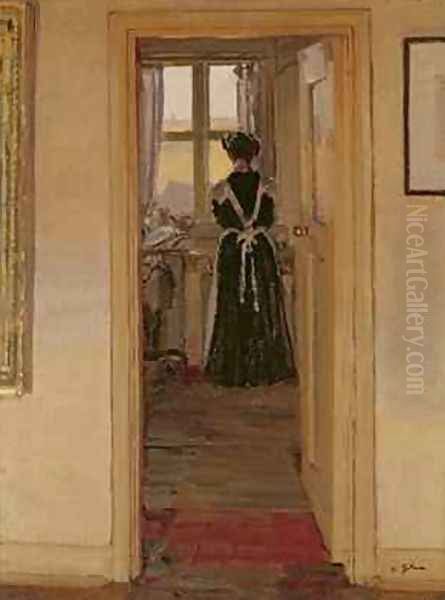
Harold John Wilde Gilman (11 February 1876 – 12 February 1919) stands as a significant figure in the landscape of early 20th-century British art. A painter celebrated for his interiors, portraits, and landscapes, he was a pivotal founding member of the influential Camden Town Group. Gilman's work is characterized by its robust use of colour, strong formal structure, and an unflinching engagement with the realities of modern urban life. His career, though tragically cut short, marked a crucial transition in British painting, absorbing the lessons of French Post-Impressionism and forging a distinctly modern, British artistic identity alongside contemporaries like Walter Sickert and Charles Ginner.
Early Life and Artistic Awakening
Born in Rode, Somerset, Harold Gilman's early life was shaped by his father's position as a clergyman. The family later moved to Snargate in Kent, where he spent his formative years. His formal education took him initially to Bradford, followed by a year studying at Brasenose College, Oxford University. Although an interest in art was present, it wasn't until 1895, while working as a tutor for a British family in Odessa, Ukraine, that Gilman formally commenced his artistic training. This experience abroad seems to have solidified his commitment to pursuing art as a vocation.
Upon returning to England, Gilman enrolled at the Hastings School of Art from 1896. Seeking a more rigorous and progressive environment, he then moved to London to study at the prestigious Slade School of Fine Art from 1897 to 1901. During his time at the Slade, he would have encountered fellow students who would also make their mark on British art. His early artistic inclinations were shaped by the prevailing tastes of the time, showing an appreciation for the tonal subtleties and compositional elegance found in the works of Spanish master Diego Velázquez and the American expatriate James McNeill Whistler. These early influences are discernible in the more restrained palette and Whistlerian aesthetic of his initial works.
The Influence of Sickert and the Fitzroy Street Group

A crucial turning point in Gilman's artistic development occurred in 1907 when he met Walter Sickert. Sickert, an established figure who had worked with Edgar Degas and was a leading proponent of modern art in Britain, became a significant mentor. Sickert recognized Gilman's potential and introduced him to the burgeoning circle of artists associated with the Fitzroy Street Group. This informal collective, centred around Sickert's studio at 19 Fitzroy Street, provided a vital forum for exhibiting work, exchanging ideas, and fostering a spirit of modernist inquiry outside the confines of the established art institutions.
Under Sickert's guidance, Gilman began to move away from his earlier, more traditional style. Sickert encouraged him to explore the complexities of Post-Impressionism, particularly the use of stronger colour, more defined forms, and subject matter drawn from everyday urban existence. The Fitzroy Street Group, which included artists like Spencer Gore and Lucien Pissarro (son of Camille Pissarro), emphasized direct observation and often depicted scenes of contemporary London life, themes that would become central to Gilman's own practice. This period marked the beginning of Gilman's engagement with a more robust, realistic, and colouristically adventurous approach to painting.
Founding the Camden Town Group
The energy and shared artistic concerns fostered within the Fitzroy Street Group eventually led to the formation of a more formal exhibiting society. In 1911, Harold Gilman became a founding member of the Camden Town Group. Named after the area of North London where Sickert and other members lived and worked, the group aimed to showcase progressive art that focused on scenes of modern urban life, often depicting the less glamorous aspects of the city and its inhabitants. Key members alongside Gilman and Sickert included Spencer Gore, Robert Bevan, Charles Ginner, Malcolm Drummond, and Walter Bayes.
The Camden Town Group held only three exhibitions (in 1911 and 1912) but had a disproportionately large impact on British art. Their style was characterized by bold, often non-naturalistic colour, simplified forms, a thick application of paint (impasto), and subject matter that ranged from music halls and domestic interiors to street scenes and portraits. Gilman was central to the group's activities and ethos, contributing works that exemplified their shared interest in capturing the texture and atmosphere of early 20th-century London.
Development of Style: Post-Impressionist Impact

The trajectory of Gilman's art was profoundly affected by the landmark exhibition "Manet and the Post-Impressionists," organized by Roger Fry at the Grafton Galleries in London in 1910. This exhibition introduced many British artists and audiences to the revolutionary works of continental masters like Paul Cézanne, Paul Gauguin, and Vincent van Gogh on a significant scale. For Gilman, the encounter with Van Gogh's work was particularly transformative. He deeply admired Van Gogh's intense colour, expressive brushwork, and emotional honesty, reportedly keeping a reproduction of a Van Gogh self-portrait hanging in his studio for inspiration.
Following this exposure, Gilman's style evolved rapidly. He embraced a much brighter, more vibrant palette, often using strong contrasts and broken colour. His brushwork became more deliberate and textured, building forms with distinct touches of paint. He also absorbed influences from Gauguin's use of flattened planes and bold outlines, and the intimate interior scenes of French painter Edouard Vuillard resonated with his own interest in domestic subjects. Gilman synthesized these influences, developing a personal style that combined Post-Impressionist techniques with a commitment to realistic observation.
Neo-Realism and Collaboration with Ginner
Among the Camden Town Group members, Gilman formed a particularly close artistic and personal bond with Charles Ginner. Both artists shared a deep admiration for Van Gogh and Gauguin and a commitment to depicting contemporary life with honesty and vigour. They travelled together, including a significant trip to Scandinavia in 1912-13, and frequently discussed and debated artistic principles. Their shared outlook led them, along with artist Robert Bevan for a brief period, to form a small, somewhat unsuccessful venture known as the "Cumberbatch Market Group".
More significantly, Gilman and Ginner developed a shared aesthetic philosophy which they articulated, sometimes referred to as "Neo-Realism." Although perhaps not a formally published manifesto in the way of Vorticism (led by Wyndham Lewis), their approach emphasized meticulous drawing, strong design, and the use of thick impasto built up in a mosaic of distinct brushstrokes. They advocated for a rejection of the atmospheric effects of Impressionism in favour of a more structured and intensely coloured representation of reality. This close collaboration and shared vision marked a distinct strand within the broader Camden Town milieu.
London Interiors and Urban Life
A significant portion of Gilman's oeuvre is dedicated to the depiction of interiors, often the modest rented rooms and lodging houses of Camden Town and later, Maple Street. These works, such as the numerous paintings of his landlady Mrs Mounter or the evocative Tea in the Bedrooms, go beyond mere documentation. Influenced by Vuillard but possessing a unique psychological weight, Gilman used these settings to explore formal arrangements of colour and pattern, often juxtaposing wallpapers, fabrics, and domestic objects in complex designs.

His interior scenes frequently possess a quiet intensity, capturing moments of solitude or domestic routine with an unsentimental eye. The figures within these spaces are often absorbed in thought or simple activities, rendered with the same careful attention to form and colour as their surroundings. Gilman's commitment to depicting the everyday extended to the broader urban environment. His painting Leeds Market (1913), now in the Tate collection, captures the bustling energy of the market hall with a vibrant palette and structured composition, showcasing his ability to handle complex scenes of modern life. London Snow Scene similarly demonstrates his skill in capturing atmospheric conditions through bold colour and form.
Portraiture and Character Study
Portraiture was another important aspect of Gilman's work. He approached his sitters with the same directness and formal rigour seen in his interiors. Rather than flattering his subjects, he sought to capture their character through careful observation of form, structure, and the telling detail. His portraits often feature friends, fellow artists, or figures from his everyday life, like his landlady Mrs Mounter, whom he painted multiple times with profound empathy and respect.
One of his most notable portraits is the Portrait of a Black Gardener (c. 1905). This work is considered historically significant as possibly the first independent, full-size portrait of a named person of Sub-Saharan African origin in British art history, painted not as an ethnographic type but as an individual. Throughout his portrait work, Gilman employed his characteristic technique of using rich colour and textured brushwork to define form and convey personality, creating images that are both formally strong and psychologically insightful. His friendship with the expressionist painter Chaïm Soutine, though perhaps less documented than other connections, might also suggest a shared interest in the expressive potential of portraiture.
Landscapes: Structure and Colour
While best known for his interiors and urban scenes, Gilman also produced compelling landscapes. His trip to Norway with Charles Ginner in 1913 proved particularly fruitful. The resulting painting, Canal Bridge, Flekkefjord, exhibited at the New English Art Club, is considered one of his masterpieces. It showcases his mature style, applying Post-Impressionist principles to the landscape genre. The work features strong structural composition, vibrant, almost Fauvist colour harmonies, and the characteristic textured application of paint, capturing the specific light and atmosphere of the Scandinavian scene.
Other landscape works, like Two Horses held at the Yale Center for British Art, demonstrate a similar approach, focusing on the underlying structure of the scene and using colour to build form and convey mood. Whether depicting the rolling hills of the English countryside or foreign vistas, Gilman's landscapes are marked by their solidity and intense visual energy, distinct from the more atmospheric concerns of earlier Impressionist landscape painting.
The War Years and Canadian Commission

The outbreak of the First World War inevitably impacted the London art scene. The Camden Town Group had evolved into the larger London Group by 1913, reflecting a broader coalition of modern artists. During the war, Gilman continued to paint, but his most significant contribution related to the conflict came in 1918. He was commissioned by the Canadian War Records Fund, under the auspices of Lord Beaverbrook, to paint a large canvas depicting Halifax Harbour in Nova Scotia, Canada.
This commission was prompted by the devastating Halifax Explosion of December 1917. Gilman travelled to Halifax to undertake the work. His painting, Halifax Harbour (1918), is notable for being his only major war-related subject. Rather than focusing on the destruction, Gilman depicted the harbour bustling with activity, perhaps symbolizing resilience and the ongoing war effort. During this period, he also worked alongside Canadian artist Arthur Lismer, who would later become a prominent member of Canada's Group of Seven, fostering connections across the Atlantic.
Anecdotes and Personal Notes
While Gilman's life was primarily dedicated to his art, some less-documented aspects add intriguing dimensions. Sources mention an early accident that may have resulted in a leg disability, though details remain scarce and seem somewhat at odds with his documented travels, including his time tutoring in Odessa. There are also mentions, often in less mainstream accounts, of Gilman possessing a keen interest in supernatural phenomena. This interest was reportedly sparked by unsettling newspaper accounts, possibly relating to a child abduction case, and may have manifested in his personal psychological experiences or dreams, though concrete evidence is limited. These facets, while perhaps peripheral to his main artistic achievements, hint at a complex inner life beneath the dedicated painter.
Final Years, Untimely Death, and Legacy
Harold Gilman continued to teach and paint actively in the final years of his life, solidifying his reputation as a leading figure in British modern art. He briefly taught at Westminster School of Art alongside Charles Ginner. Tragically, his promising career was cut short. He contracted the Spanish Flu during the devastating pandemic that swept the globe after the war and died in London on 12 February 1919, just one day after his 43rd birthday. An unfinished work like An Eating House (1913-14), possibly inspired by Van Gogh's Interior of a Restaurant, hints at the directions his art might have further explored.

Despite his relatively short career, Harold Gilman's influence was profound. He played a crucial role in disseminating the principles of Post-Impressionism within Britain, adapting the innovations of artists like Van Gogh, Gauguin, and Vuillard into a distinctly English idiom. As a key member of the Fitzroy Street and Camden Town Groups, he helped shape a movement that revitalized British painting, focusing on modern subject matter rendered with bold colour and formal experimentation. His dedication to realism, combined with his advanced understanding of colour and form, marks him as a vital link between the generation of Sickert and the subsequent developments in British modernism. His works are held in major public collections, including Tate Britain, the Ashmolean Museum, the British Museum, the Yale Center for British Art, and the National Portrait Gallery, ensuring his contribution continues to be recognized and studied.